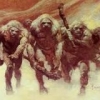Comments on the "Tree Manipulation" part of the topic.
BF definitely manipulates trees for various reasons. The primary reasons are for trail and territorial markers, as well as obvious displays of raw strength intended as warnings to humans - and possibly for other BF - to stay out of certain areas. The most notable examples of the "raw strength" markers are around the perimeter of a family's bedding area. Those markers are usually located at the most likely points of entry into the general bedding areas and are usually within a half mile or so of each of the multiple general bedding/safe-haven areas they use. (When food or water sources are scarce they may forage over many square miles and have bedding spots along their travel routes.)
The living trees they manipulate along their trails are usually not very large – about two to five inches in diameter – and are typically soft-wood varieties. The trees are nearly always broken over their trails, but if the tree snaps off, the top is laid across the trail.
When larger trees – about five inches or more - are broken, twisted or bent over by partially up-rooting them, that typically indicates that a BF bedding/safe haven area is nearby, or sign that BF are seriously displeased with humans that are intruding and claiming part of their home territory.
.
As in several cases I have investigated, BF have used the "raw strength" displays to vividly show their displeasure when people clear an area and place or build a home on land they have routinely used as a travel route or prime foraging area for years. In many such cases, the BF will continue to pass through the area and will harass and try to intimidate the "intruders" for years.
It is not difficult to determine, with a great deal of certainty, when trees like those described above have been manipulated by a BF. The most obvious and compelling evidence is that the bark on the small trees is very noticeably abraded around the circumference at one location at a width of a large hand. It may be noted that small limbs/twigs on the trunk at that location are crushed and wrapped around the trunk. If the tree is twisted to make the break the abrasion will be more noticeable. The abrasion and bent twigs will be only a short distance from the break in the trunk. Small pine, cedar and gum trees typically display the conditions described when manipulated by a BF. If the damage is fresh, footprints or foot impressions can usually be seen by close observations. (Hunter’s often break very small trees as trail markers, but it is usually only the upper part of those trees. Both boar and sow feral hogs bite off the tops of small evergreens and softwoods with new foliage and leave it or may carry it off to make a bed for an expected litter.)
The larger tree they manipulate – typically pines, cedar, gums and maple – will typically show that the force and torque needed to break, bend or twist the tree will, in addition to abrading the bark, actually loosen the bark from the cambium layer of the tree at two or more locations on the trunk where their hands gripped it. On these larger trees, especially those which are more readily broken by bending and twisting, one or more of the damaged areas may be at strong limb locations so that the limbs can be used for torque and bending pressure points. It is not unusual to see that the bark on those limbs near the trunk are abraded, with portions of the bark on them having been loosened from their cambium layers as well.
BF are known to manipulate (bend over) certain softwood trees in the early spring to eat the new buds on the trees.
When black cherry trees have mature fruit in the summer, it is common to see limbs broken off the upper parts of the trunks, and the broken limbs found pulled together in a pile in a spot under the tree. Invariably such conditions are the work of black bear. Their claw marks will be clearly visible on the bark of the trees, and the impression of their butts can be found in the center of the pile of fruit laden limbs. The bear hardly ever eat all the cherries, and the coyotes get a free meal.



